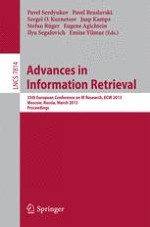2013 | Book
Advances in Information Retrieval
35th European Conference on IR Research, ECIR 2013, Moscow, Russia, March 24-27, 2013. Proceedings
Editors: Pavel Serdyukov, Pavel Braslavski, Sergei O. Kuznetsov, Jaap Kamps, Stefan Rüger, Eugene Agichtein, Ilya Segalovich, Emine Yilmaz
Publisher: Springer Berlin Heidelberg
Book Series : Lecture Notes in Computer Science
